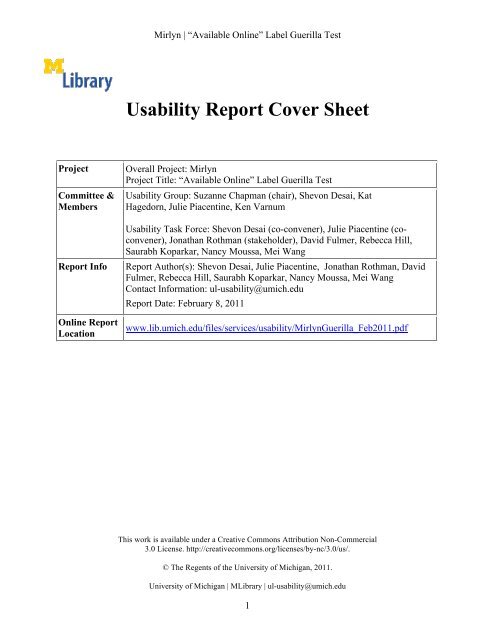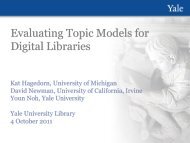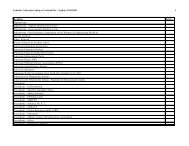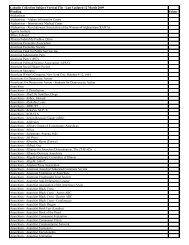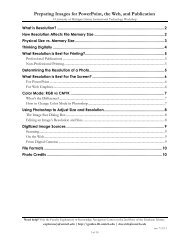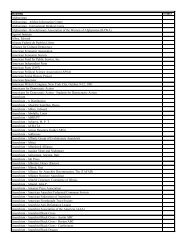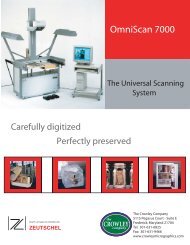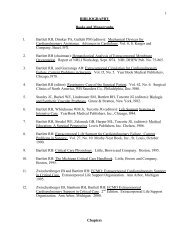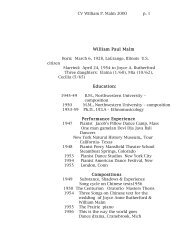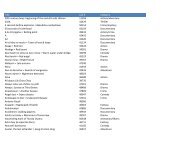Usability Report Cover Sheet - University of Michigan
Usability Report Cover Sheet - University of Michigan
Usability Report Cover Sheet - University of Michigan
Create successful ePaper yourself
Turn your PDF publications into a flip-book with our unique Google optimized e-Paper software.
Mirlyn | “Available Online” Label Guerilla Test<br />
<strong>Usability</strong> <strong>Report</strong> <strong>Cover</strong> <strong>Sheet</strong><br />
Project Overall Project: Mirlyn<br />
Project Title: “Available Online” Label Guerilla Test<br />
Committee &<br />
Members<br />
<strong>Usability</strong> Group: Suzanne Chapman (chair), Shevon Desai, Kat<br />
Hagedorn, Julie Piacentine, Ken Varnum<br />
<strong>Usability</strong> Task Force: Shevon Desai (co-convener), Julie Piacentine (coconvener),<br />
Jonathan Rothman (stakeholder), David Fulmer, Rebecca Hill,<br />
Saurabh Koparkar, Nancy Moussa, Mei Wang<br />
<strong>Report</strong> Info <strong>Report</strong> Author(s): Shevon Desai, Julie Piacentine, Jonathan Rothman, David<br />
Fulmer, Rebecca Hill, Saurabh Koparkar, Nancy Moussa, Mei Wang<br />
Contact Information: ul-usability@umich.edu<br />
Online <strong>Report</strong><br />
Location<br />
<strong>Report</strong> Date: February 8, 2011<br />
www.lib.umich.edu/files/services/usability/MirlynGuerilla_Feb2011.pdf<br />
This work is available under a Creative Commons Attribution Non-Commercial<br />
3.0 License. http://creativecommons.org/licenses/by-nc/3.0/us/.<br />
© The Regents <strong>of</strong> the <strong>University</strong> <strong>of</strong> <strong>Michigan</strong>, 2011.<br />
<strong>University</strong> <strong>of</strong> <strong>Michigan</strong> | MLibrary | ul-usability@umich.edu<br />
1
Introduction<br />
Mirlyn | “Available Online” Label Guerilla Test<br />
<strong>Usability</strong> <strong>Report</strong><br />
"Available online" is a label which appears in Mirlyn and signifies that at least one item attached<br />
to a bibliographic record is fully available online. The extent <strong>of</strong> the online availability varies and<br />
a single fully available online item, such as a single issue <strong>of</strong> a journal, will result in the display <strong>of</strong><br />
the "available online" label in the Mirlyn record <strong>of</strong> that. The degree to which there is any online<br />
availability can vary wildly. If there is a 20 year run <strong>of</strong> a journal (with each year bound as a<br />
single volume), and even one <strong>of</strong> those volumes is available in full-text online, the 'available<br />
online' label appears. The label also appears in the records <strong>of</strong> monographs, maps, and audio<br />
recordings with online availability.<br />
The "available online" label appears also in Mirlyn as clickable text under the "Availability"<br />
search narrowing option in the "Narrow Search" column <strong>of</strong> search results pages and as the text <strong>of</strong><br />
the hyperlink to the online version <strong>of</strong> an item which appears in search results and Mirlyn record<br />
web pages.<br />
Example within “Narrow Search” Column<br />
Example <strong>of</strong> "available online" label within Mirlyn record<br />
The earlier heuristic evaluation <strong>of</strong> Mirlyn conducted by the usability task force, and feedback<br />
from both staff and patrons indicate that the meaning <strong>of</strong> the “available online” label can be<br />
confusing. Reference librarians report that patrons are <strong>of</strong>ten frustrated when items described as<br />
“available online” are not, in fact, available (the particular issue needed might not be available in<br />
full-text, or the patron might be looking at something that is “search-only”).<br />
The need to test alternative labels arose as plans to retire the umbrella category “Electronic<br />
Resource” developed. Previously, “Electronic Resource” denoted any item with electronic<br />
functionality, including CD-ROMs, data files, and online items, including HathiTrust full-text<br />
and search-only items. As “Electronic Resource” is replaced with more specific sub-categories<br />
(i.e., CD-ROM, data files, etc.), stakeholders considered the possibility <strong>of</strong> replacing the separate<br />
but related “Available Online” label. Because these two labels frequently overlapped, user<br />
confusion resulted in distrust <strong>of</strong> both labels. It was hypothesized that a label change might help<br />
users identify items that may be viewed online.<br />
The goal <strong>of</strong> this guerilla test was to determine which <strong>of</strong> four labels (three alternate labels, in<br />
addition to the current “available online” label) denoting online availability is preferred by<br />
patrons, taking time to ensure that patrons understand the range <strong>of</strong> situations currently<br />
<strong>University</strong> <strong>of</strong> <strong>Michigan</strong> | MLibrary | ul-usability@umich.edu<br />
2
Mirlyn | “Available Online” Label Guerilla Test<br />
represented by the "available online" label. We also solicited suggestions for alternate labels<br />
from participants.<br />
Test Description & Methods<br />
Four different screenshots <strong>of</strong> Mirlyn search results were displayed to each participant. Each<br />
screenshot depicted the same set <strong>of</strong> results, the only difference being the label used in place <strong>of</strong><br />
“available online.” The different items included in the search results were chosen specifically to<br />
illustrate the varying levels <strong>of</strong> online access reflected by the “available online” label.<br />
Four different labels were tested:<br />
• available online<br />
• some content fully available online<br />
• electronic resource<br />
• online content available<br />
Within each set <strong>of</strong> search results, the label in question was highlighted as to draw attention to the<br />
difference between the screenshots. The varying levels <strong>of</strong> availability for different types <strong>of</strong> items<br />
within the set <strong>of</strong> search results were briefly described to the participants, and participants were<br />
asked to choose which label best described all the situations they saw.<br />
Partial image <strong>of</strong> 1 <strong>of</strong> the 4 screenshots used for guerilla test, testing the label “Online Content Available”<br />
<strong>University</strong> <strong>of</strong> <strong>Michigan</strong> | MLibrary | ul-usability@umich.edu<br />
3
Mirlyn | “Available Online” Label Guerilla Test<br />
Partial image <strong>of</strong> another screenshot used for guerilla test, testing the label “Some Content Fully<br />
Available Online”<br />
The task force group divided into three teams, with each team recruiting 5 participants<br />
(undergraduates, graduate students, and faculty) and 1-2 librarians each. Participants were<br />
recruited in various locations around campus, and were <strong>of</strong>fered a small incentive <strong>of</strong> $2 in<br />
Munchie Money.<br />
Task force members noted the participants’ comments about the label chosen and why, along<br />
with suggestions for other labels not included in the test and any other observations.<br />
Results<br />
The task force began by conducting pilot tests. Because there were no significant changes made<br />
as a result <strong>of</strong> the pilot testing, we have included the 9 pilot tests with the final results. However, 3<br />
<strong>of</strong> these 9 pilot tests were conducted testing only 3 <strong>of</strong> the 4 labels – “electronic resources” was<br />
added later, at the stakeholder’s request. Based on the overall results, this difference in the first<br />
guerilla tests did not appear to be significant (only 3 <strong>of</strong> 26 people chose “Electronic Resource”).<br />
Total number <strong>of</strong> test participants: 29<br />
• Undergraduate students: 16<br />
• Graduate students: 6<br />
• Library Staff: 6<br />
• Faculty Member: 1<br />
Locations where the guerrilla tests were conducted:<br />
<strong>University</strong> <strong>of</strong> <strong>Michigan</strong> | MLibrary | ul-usability@umich.edu<br />
4
Mirlyn | “Available Online” Label Guerilla Test<br />
• Duderstadt Center, North Campus<br />
• Undergraduate Library - atrium, Bert’s Café, and first floor study areas<br />
• Graduate Library Reference and Information Center, 2 nd floor<br />
• Angell Hall building entrance<br />
• North Quad<br />
• Science Library Conference Room<br />
Question 1-A: Which <strong>of</strong> these terms - "available online, "some content fully available<br />
online" “electronic resource” or "online content available" - do you think best applies to<br />
all situations?<br />
Label Name Number <strong>of</strong> Type <strong>of</strong> User<br />
testers<br />
(total=29) Undergraduate Graduate Library Faculty<br />
Staff Member<br />
Available<br />
9 4 2 2 1<br />
Online<br />
Some Content<br />
Fully Available<br />
Online<br />
Online Content<br />
Available<br />
Electronic<br />
Resource<br />
9 4 2 3 0<br />
7 5 1 1 0<br />
3 2 1 0 0<br />
• Both “some content fully available online” and “available online” were the most<br />
popular labels, the preferred choice <strong>of</strong> 9 participants each.<br />
Question 1-B: Can you tell us why you chose this label?<br />
1. Participants who chose ‘Available Online’ (9)<br />
Responses indicated that participants who chose “available online” felt that this label was short<br />
and meaningful, although it was not necessarily completely truthful in conveying how much<br />
content was available online. According to users, this label sounded more clear, familiar, and <strong>of</strong><br />
the right word length. It should be noted that “available online” is the term currently used in<br />
Mirlyn.<br />
Selected responses by users who chose ‘available online’:<br />
<strong>University</strong> <strong>of</strong> <strong>Michigan</strong> | MLibrary | ul-usability@umich.edu<br />
5
Mirlyn | “Available Online” Label Guerilla Test<br />
• “… it (available online) sounds most clear especially because it says available…”<br />
[library staff member]<br />
• Available online “means everything.” The participant said, “After clicking on<br />
‘available online’, I would figure out from there how to get what I need online.”<br />
[graduate student]<br />
• “It (available online) tells me immediately that information is available online…”<br />
[undergraduate student]<br />
• “It (available online) reads better.” [librarian]<br />
• The participant said that this label “makes most sense” when compared to ‘online<br />
content available,’ which is similar in meaning. The participant also said that “some<br />
content fully available online” is too long. [undergraduate student]<br />
2. Participants who chose “Some Content Fully Available Online” (9)<br />
These users felt that this label sounded true and meaningful for all situations, but was not short in<br />
length. The label was considered most descriptive by users, because it clearly meant that some<br />
items, and not all, would be available online. A few users misunderstood that this label referred<br />
to HathiTrust full-text and search-only items in the catalog.<br />
Selected responses by users who chose “some content fully available online”:<br />
• One participant said that until she learned what HathiTrust was, it was really<br />
frustrating for her to think something would be available online and then realize that<br />
it was not. It is not clear from the comment whether the participant was referring to<br />
records where some volumes are fully available online and others are search-only, or<br />
whether she was referring to strictly search-only items.<br />
• This participant was <strong>of</strong> the opinion that the word “some” in this label is better than all<br />
others. The user remarked that “available online” is the same as “online content<br />
available,” and that “electronic resource” is not detailed enough (to understand).<br />
[graduate student]<br />
• One participant felt that this label was “more inclusive” than others. [undergraduate<br />
student]<br />
• One participant mentioned that this label is clearer because it says some and not all<br />
content is available online. The label being wordy did not bother this user.<br />
[undergraduate student]<br />
<strong>University</strong> <strong>of</strong> <strong>Michigan</strong> | MLibrary | ul-usability@umich.edu<br />
6
Mirlyn | “Available Online” Label Guerilla Test<br />
3. Participants who chose ‘Online Content Available’ (7)<br />
Participants’ comments about this label seemed to indicate that while it is short and truthful, it is<br />
not adequately meaningful, recognizable, or compelling.<br />
Selected responses by users who chose “Online Content Available”:<br />
• One participant said that she preferred this label because it included both ‘some and<br />
all’ electronic access. [undergraduate student]<br />
• Another participant was <strong>of</strong> the opinion that this label did not guarantee everything is<br />
online but it guarantees electronic access. [librarian]<br />
4. Participants who chose ‘Electronic Resource’ (3)<br />
Very few participants preferred this label. One comment from a participant indicated that<br />
‘Electronic Resource’ is appropriately ambiguous – users would need to click through to find out<br />
specifically what is available online. In contrast, another participant who chose “Electronic<br />
Resource” found the label unambiguous, ruling out search-only items or items that are “not as<br />
available.”<br />
Selected responses by users who chose “Electronic Resource”:<br />
• This participant felt that this label suggests that the resource can be obtained on the<br />
internet: “…it’s digitized, while the word ‘some’ [in the label ‘Some Content Fully<br />
Available Online’] means it is not as available.” [graduate student]<br />
• One student explained that if she had to choose one label for all situations then<br />
"electronic resource" was her favorite because it indicates that something is available<br />
online and "you have to click to find out what's there." [undergraduate student]<br />
Question 2 – Labels suggested by participants<br />
A few participants suggested their own labels, listed below:<br />
• “Print and electronic”<br />
• “Available print and online”<br />
• “Some content online”<br />
• “Some content available online”<br />
• “Some full text content available online”<br />
Comments worth mentioning:<br />
<strong>University</strong> <strong>of</strong> <strong>Michigan</strong> | MLibrary | ul-usability@umich.edu<br />
7
Mirlyn | “Available Online” Label Guerilla Test<br />
Some participants had intense reactions after seeing certain label options. This can be illustrated<br />
by the following examples:<br />
• A graduate student felt that ‘some content fully available online’ and ‘online content<br />
available’ are “discouraging.”<br />
• An undergraduate student called the label “some content fully available online”<br />
‘obnoxious.’<br />
• A library staff member said that the label “Online Content Available” “sounds kind <strong>of</strong><br />
sketchy.”<br />
Recommendations<br />
Continue to use the 'available online' label<br />
Test results showed that participants did not strongly prefer any one label over another. The two<br />
labels most preferred by participants were "some content fully available online" and "available<br />
online."<br />
We recognize that 32% (9 out <strong>of</strong> 28) <strong>of</strong> participants in favor <strong>of</strong> the current label “available<br />
online” is not an overwhelming number, and that the majority <strong>of</strong> testers preferred some other<br />
label. However, we recommend continued use <strong>of</strong> the current label for a variety <strong>of</strong> reasons:<br />
• All labels must find an appropriate balance between length,<br />
meaningfulness, and truth/accuracy (see image at right,<br />
courtesy <strong>of</strong> Suzanne Chapman). "Some content fully<br />
available online" is lengthy, although meaningful and true.<br />
“Available online,” while lacking in a detailed level <strong>of</strong><br />
accuracy, effectively conveys meaning and is appropriate in<br />
length.<br />
• The label "some content fully available online" garnered strong negative reactions,<br />
described above.<br />
• Since “available online” is one <strong>of</strong> the two top choices preferred by our test<br />
participants, and it is the current label being used, switching to a different label at this<br />
point would be unnecessarily disruptive without apparent strong benefit.<br />
<strong>University</strong> <strong>of</strong> <strong>Michigan</strong> | MLibrary | ul-usability@umich.edu<br />
8
Lessons Learned<br />
What Went Well<br />
Mirlyn | “Available Online” Label Guerilla Test<br />
The test itself was well-designed. Pilot testing showed us that participants understood the<br />
questions and no major changes were necessary.<br />
The four labels presented during the guerilla test were carefully chosen and appeared to be<br />
sufficient choices. Most participants preferred one <strong>of</strong> the labels <strong>of</strong>fered and did not have<br />
additional suggestions.<br />
The guerilla test approach suited the question we were asking; the test was not too long, and we<br />
had no trouble recruiting participants.<br />
What Did Not Go Well<br />
There were no significant problems with the guerilla testing.<br />
Ideas for Future Testing<br />
As with most usability testing, having a larger sample <strong>of</strong> participants would be helpful,<br />
especially since no single label was a “clear winner.” If the test were longer than a guerilla test,<br />
we could also include questions that would more accurately determine the user’s level <strong>of</strong><br />
familiarity with Mirlyn, in order to better gauge their understanding <strong>of</strong> all the different<br />
possibilities needing to be conveyed by the “available online” label.<br />
<strong>University</strong> <strong>of</strong> <strong>Michigan</strong> | MLibrary | ul-usability@umich.edu<br />
9
Appendix A<br />
Mirlyn Guerilla Test Script<br />
Mirlyn | “Available Online” Label Guerilla Test<br />
REMINDERS: Have one person administer the test and the other write down any comments,<br />
questions and answers. Note your location, and anything else that may influence the person’s answers.<br />
INTRODUCE yourself and ask if willing to help:<br />
Hi, I’m ___________ and this is _______________ from the library. Do you have 7-8 minutes to help us<br />
answer some questions about the library website? We can give you $2 in Munchie Money for your time.<br />
Any information you give us will be kept anonymous.<br />
First, would you please tell us if you are an undergrad, a graduate student, faculty member, staff member,<br />
etc.<br />
SET UP:<br />
I'm going to show you screenshots <strong>of</strong> Mirlyn, the library catalog. Mirlyn is where you would go to search<br />
for all the different kinds <strong>of</strong> resources that the Library has: journals, books, ebooks, musical scores, etc.<br />
Here are four print-outs from Mirlyn all showing the same search results. There is just one slight<br />
difference, which is highlighted. This is a label -- not a link -- which describes access to these items.<br />
Label preference set up:<br />
[Point to Dickens] This is a book that is available both in print as well as electronically.<br />
[Pointing to map] This item is a map <strong>of</strong> Pennsylvania that you can both look at in print as well as view<br />
electronically.<br />
[Pointing to British Journal <strong>of</strong> Health Psych] You can read issues <strong>of</strong> British Jnl <strong>of</strong> Health Psychology<br />
up through 2004 electronically, but not more recent ones.<br />
QUESTION 1: Which <strong>of</strong> these terms -- [point to each], "available online, "some content fully available<br />
online," “electronic resource” or "online content available" -- do you think best applies to all situations?<br />
Can you tell us why? There’s no right answer; we just want to know your preference.<br />
QUESTION 2: Label suggestion question:<br />
Is there a better term you would suggest for this?<br />
One sentence description <strong>of</strong> other items, in case the person asks about them:<br />
[Soldier's tale]: This is a piece <strong>of</strong> music; you can either check out the CD or listen to it online.<br />
Critical Care Nurse is a journal for which you can read certain issues electronically, but not all issues<br />
<strong>University</strong> <strong>of</strong> <strong>Michigan</strong> | MLibrary | ul-usability@umich.edu<br />
10


